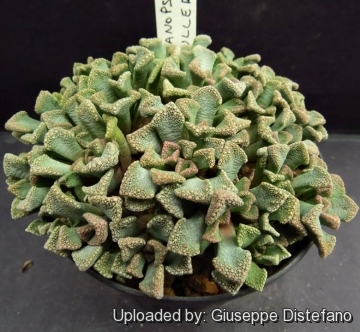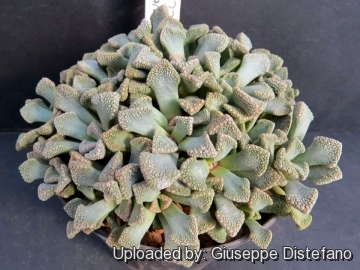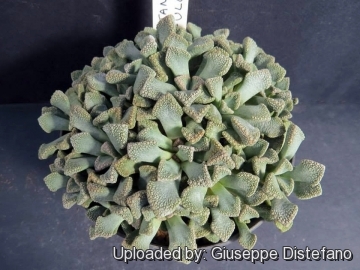Accepted Scientific Name: Titanopsis calcarea (Marloth) Schwantes
Z. Sukkulentenk. ii. 178 (1926)

Titanopsis fulleri Photo by: Giuseppe Distefano
Origin and Habitat: South Africa, Cape Province. (Bushmanland, Upper Karoo)
Habitat: With a white incrustation to the leaves, it is confined to solid limestone outcrops. This is probably a rare case of protective coloration in plants akin to that found in the animal kingdom and the leaves blend into the plant's stony environment.
Synonyms:
See all synonyms of Titanopsis calcarea
back
Accepted name in llifle Database:Titanopsis calcarea (Marloth) SchwantesZ. Sukkulentenk. ii. 178 (1926)Synonymy: 4
Cultivars
(2):
back
Common Names include:
AFRIKAANS (Afrikaans): Kalkrosie
Description: Titanopsis fulleriSN|12601]]SN|12601]] is a more or less distinct populations of Titanopsis calcareaSN|12599]]SN|12599]] with flater, erect leaves. It is a low growing, mat forming succulent plant with bluish green basal rosettes formed of 5 or 6 pairs of leaves covered with dark raised dots. The markings closely resemble the rock structure in which they are found. Its blooms are deep yellow.
Rosettes: 4-5 cm wide, each containing 5 or 6 pairs of leaves.
Leaves: With roundish triangular tip 2-2.2 cm long, c. 4 mm broad towards the base to 10 mm broad above. The backs of the leaves are roundly keeled, the upper surface flat and slightly concave. The leaves are a beautiful blue-green with a reddish tinge, the surface covered with with dark dots along the margins. This wart-like roughness can vary in colour from almost pure white to creamy grey, ochre, greyish-brown, bluish, or red on a purple ground. The thickness of the crystal layer in the outer epidermal wall decreases rapidly from the tip into the valleys between the warts, which therefore stand out more prominently than in the other species.
Flowers: To 16-18 mm in diameter, dark yellow in late autumn and winter. Titanopsis will often have a 'sneak' opening on a sunny afternoon and then appear to be tightly closed for a week or more until another suitable time occurs.
Taxonomic note: Material of Titanopsis fulleri matches Titanopsis calcareaSN|12599]]SN|12599]] in fruit shapes and seed characters completely, both features separating this complex from the other species. Nevertheless, forms with more erect leaves exhibiting warts on a margin rather than on a terminal triangle are often treated as Titanopsis fulleriSN|12601]]SN|12601]]. Plants with these deviating leaves can form populations of their own or occur mixed with plants typical of T. calcarea.
Subspecies, varieties, forms and cultivars of plants belonging to the Titanopsis calcarea group
Notes: The Genus Titanopsis comprises three to six species, depending on botanists' opinions. Some botanists have now lumped Titanopsis lüderitzii and Titanopsis primosiiSN|13463]]SN|13463]] in with Titanopsis schwantesii.
The species list for Titanopsis is considered to be Titanopsis calcareaSN|12601]]SN|12599]], Titanopsis fulleriSN|12599]]SN|12601]] ( = calcarea ), Titanopsis hugo-schlecteri, Titanopsis lüderitzii ( = schwantesii ), Titanopsis primosiiSN|13463]]SN|13463]] ( = schwantesii ), Titanopsis schwantesii
Bibliography: Major references and further lectures
1) Heidrun E. K. Hartmann “Aizoaceae F – Z” Springer, 2002
2) James Cullen, Sabina G. Knees, H. Suzanne Cubey “The European Garden Flora Flowering Plants: A Manual for the Identification of Plants Cultivated in Europe, Both Out-of-Doors and Under Glass - Casuarinaceae to Aristolochiaceae” Cambridge University Press, 11/ago/2011
3) Hermann Jacobsen, Vera Higgins “Succulent Plants: Description, Cultivation and Uses of Succulent Plants, Other Than Cacti” Williams and Norgate, Limited, 1935
4) Jacobsen. “Handbook of succulent plants” 1960
5) H. Herre “The genera of the Mesembryanthemaceae” Tafelberg-Uitgewers Beperk, 1971
6) The Cactus and Succulent Journal of Great Britain, Volume 39 Copertina anteriore
Cactus & Succulent Society of Great Britain., 1977
7) Thomas H. Everett "The New York Botanical Garden Illustrated Encyclopedia of Horticulture" Volume 10 Taylor & Francis, 1982
8) S. H. Scott "The Observer's Book of Cacti and Other Succulents" F. Warne, 1958
9)R. Ginns "A guide to cactus and succulent plants" (c/o B. C. F. Hill, 10 Downfield Close, Llandough, Penarth, Glam.)], National Cactus and Succulent Society, 1971
10) Ernst Van Jaarsveld, Ben-Erik Van Wyk, Gideon Smith "Succulents of South Africa: A Guide to the Regional Diversity" Tafelberg, 2000
 Titanopsis fulleri Photo by: Giuseppe Distefano
Titanopsis fulleri Photo by: Giuseppe Distefano Titanopsis fulleri Photo by: Giuseppe Distefano
Titanopsis fulleri Photo by: Giuseppe Distefano Titanopsis fulleri Photo by: Giuseppe Distefano
Titanopsis fulleri Photo by: Giuseppe DistefanoSend a photo of this plant.The gallery now contains thousands of pictures, however it is possible to do even more. We are, of course, seeking photos of species not yet shown in the gallery but not only that, we are also looking for better pictures than those already present.
Read More... Cultivation and Propagation: This species is easy to grow and clumps readily, forming a beautiful succulent mat. Needs moderate water when growing in late fall and early spring. Keep somewhat dry the rest of the time. Like all living rocks, they thrive in porous soils with excellent drainage. It can tolerates high heat and heavy frost (hardy to -10° C). It is a very rewarding succulent, and can be cultivated in desert gardens in warm climates or in greenhouses or windowsills in the home. Enjoys bright shade in summer and full sun in the other seasons.
Propagation: They grow quickly from seed or by division of larger clumps.













